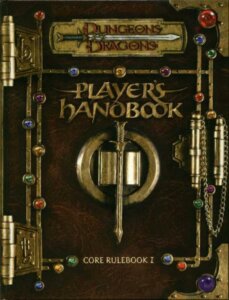This is Part 3 in a multipart series. You can also start with Part 1 or jump back to Part 2 .
What’s with all the different versions of D&D? Are there really 5 editions? If you’re new to the hobby, or maybe stopped playing back in the 80s, there can be a lot to sort out when it comes to the world’s most popular tabletop RPG. This time around, we’re dropping the A from AD&D and delving into the first modern edition.
DUNGEONS & DRAGONS (3rd Edition)

History: By the late 1990s, TSR, the company who published Dungeons & Dragons, was in real financial trouble. Enter Wizards of the Coast, who had found tremendous success with Magic: The Gathering. In 1997, Wizards purchased TSR and with it, Dungeons & Dragons. And new ownership meant a new D&D.
Third Edition Dungeons & Dragons debuted at GenCon 2000. Originally, there had been two distinct and concurrent brands of the game: Dungeons & Dragons and Advanced Dungeons & Dragons. Technically, the new D&D was a version of Advanced Dungeons & Dragons but, since the basic game no longer existed, Wizards of the Coast dropped the word advanced from the title.
In many ways, 3E was the first modern version of the D&D rules. The designers of previous D&D versions had attempted to stay close to the existing rules as written. The 3E authors were more willing to make changes, and many of those new rules would go on to become standard features of D&D. Armor class now went up instead of down, characters of all classes shared the same experience table, and sorcerers made their first appearance as a distinct character class.
3E was a financial and critical success, and the tabletop roleplaying hobby in general grew following its publication. If the goal of Wizards of the Coast was to save Dungeons & Dragons from falling into obscurity, then 3E certainly achieved that goal.
Appearance: Like previous versions of AD&D, 3E presented in three “core rulebooks” consisting of the Player’s Handbook, the Dungeon Master’s Guide, and the Monster Manual. Rather than traditional fantasy cover art, each book looks like a medieval tome.
DUNGEONS & DRAGONS 3RD EDITION REVISED (3.5)
History: Published in 2003, just a few years after 3E made its debut, 3.5 doesn’t represent a new edition so much as a cleaning up and rebalancing of the rules. Notably, the designers made significant changes to the ranger class, tweaked a number of spells, and added more content to each of the three core rulebooks. The revised version is almost completely compatible with 3E, and in many cases the two rulesets are identical.
Appearance: The 3.5 core rulebooks appear very similar to their 3E predecessors, with each volume resembling a decorative medieval tome. Notably, each of the core rulebooks contains the words “V 3.5” on its spine.
THE OPEN GAMING LICENSE
Before we go, it’s worth mentioning that this period of time also saw the creation of the Open Gaming License (OGL) and the d20 License. Essentially, the OGL allowed third-party publishers to create and sell content for D&D. The d20 License was a special agreement that allowed a publisher to use a specific logo to show a book’s compatibility with 3E/3.5E D&D. To learn more about the OGL and its impact on the RPG hobby and industry, check out this expanded article.
Next…
This is an ongoing series of articles. In Part 4 we go a little controversial with 4th Edition D&D. Or you can go back to check out Part 1 or Part 2 of this series.

